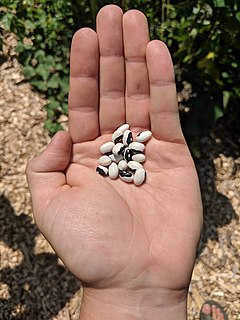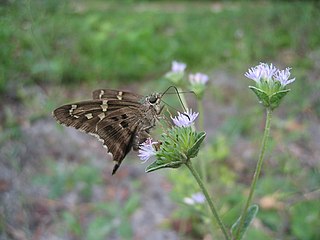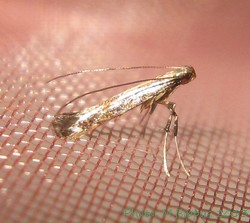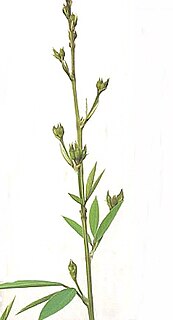Related Research Articles

A bean is the seed of one of several genera of the flowering plant family Fabaceae, which are used as vegetables for human or animal food. They can be cooked in many different ways, including boiling, frying, and baking, and are used in many traditional dishes throughout the world.

A legume is a plant in the family Fabaceae, or the fruit or seed of such a plant. The seed is also called a pulse. Legumes are grown agriculturally, primarily for human consumption, for livestock forage and silage, and as soil-enhancing green manure. Well-known legumes include alfalfa, clover, beans, peas, chickpeas, lentils, lupins, mesquite, carob, soybeans, peanuts, and tamarind. Legumes produce a botanically unique type of fruit – a simple dry fruit that develops from a simple carpel and usually dehisces on two sides.

The Luna moth is a Nearctic moth in the family Saturniidae, subfamily Saturniinae, a group commonly known as giant silk moths. It has lime-green colored wings and a white body. The larvae (caterpillars) are also green. Typically, it has a wingspan of roughly 114 mm (4.5 in), but can exceed 178 mm (7.0 in), making it one of the larger moths in North America. Across Canada, it has one generation per year, with the winged adults appearing in late May or early June, whereas farther south it will have two or even three generations per year, the first appearance as early as March in southern parts of the United States.

Helicoverpa zea, commonly known as the corn earworm, is a species in the family Noctuidae. The larva of the moth Helicoverpa zea is a major agricultural pest. Since it is polyphagous during the larval stage, the species has been given many different common names, including the cotton bollworm and the tomato fruitworm. It also consumes a wide variety of other crops.

The small blue is a Palearctic butterfly in the family Lycaenidae. Despite its common name, it is not particularly blue. The male has some bluish suffusion at the base of its upper wings but is mostly dark brown like the female. The species can live in colonies of up to several hundred and in its caterpillar stage is cannibalistic.

The long-tailed skipper is a spread-winged skipper butterfly found throughout tropical and subtropical South America, south to Argentina and north into the southern part of the United States of America. It cannot live in areas with prolonged frost. It is a showy butterfly, with wings of light brown tinted with iridescent blue, and two long tails extending from the hindwings. The robust body is light blue dorsally. It has a large head, prominent eyes, and a wingspan between 4.5 and 6 centimeters.

Atalopedes campestris is a small grass skipper butterfly. It has a wingspan of 35–41 mm. Male is orange, edged with brown, and has a large brown-black stigma. Female is darker with lighter markings in the center of the wing.

Zizina labradus, the common grass blue, grass blue, or clover blue, is a small Australian butterfly of the family Lycaenidae.

Crocidolomia pavonana is a moth of the family Crambidae. Its caterpillar is a crop pest and is known as the croci or the cabbage cluster caterpillar. This moth is found in Africa and Asia, its range extending from South Africa through India to the Pacific Ocean, including Australia. The wingspan is about 25 mm (1 in). The larvae feed on Brassicaceae species and are considered an agricultural pest on cabbages. At first, they feed only on the undersides of the leaves. Later they feed on the rest of the leaves and the central shoot. The species was first described by Johan Christian Fabricius in 1794.

Cricula trifenestrata, the cricula silkmoth, is a species of wild silk moth of the family Saturniidae. It is found from India to the Philippines, Sulawesi, Java, and Sri Lanka.
Cryptophlebia ombrodelta, the litchi fruit moth or macadamia nut borer, is a moth of the family Tortricidae. The species was first described by Oswald Bertram Lower in 1898. It is native to India, Sri Lanka, Nepal, Indonesia, China, Taiwan, Vietnam, Thailand, western Malaysia, New Guinea, the Philippines, Japan, Guam, the Caroline Islands, Australia and has been introduced to Hawaii.

Hellula undalis, the cabbage webworm or Old World webworm, is a moth of the family Crambidae. It is a widespread species which is found from Europe across Asia to the Pacific. It was first described from Italy.

Cryptophlebia illepida is a species of moth in the family Tortricidae that is endemic to the islands of Kauaʻi, Oʻahu, Molokaʻi, Maui, Lānaʻi and Hawaiʻi. Common names include koa seedworm, klu tortricid, koa seed moth, litchi borer, litchi moth, macadamia nut borer and macadamia nut moth. It was first described by Arthur Gardiner Butler in 1882.
Cydia parapteryx is a moth of the family Tortricidae. It was first described by Edward Meyrick in 1932. It is endemic to the Hawaiian island of Oahu.

Phodoryctis caerulea is a moth of the family Gracillariidae. It is known from India, Malaysia (Sabah), Indonesia (Java), Sri Lanka, Fiji, Guam, the Solomon Islands, Japan and Taiwan, as well as Tanzania.

Conopomorpha flueggella is a moth of the family Gracillariidae. It is known from Tianjin, China.

Elasmopalpus is a monotypic snout moth genus described by Émile Blanchard in 1852. Its single species, Elasmopalpus lignosellus, the lesser cornstalk borer, was described by Philipp Christoph Zeller in 1852. It is found from the southern United States to Mexico, Central America and South America. It is also found on the Bahamas.
Andraca theae is a moth of the family Endromidae. It is widely distributed in Taiwan and Southern China.
Mesophleps adustipennis, the soybean webworm moth, is a moth of the family Gelechiidae. It is found in the western and southern parts of the United States, Mexico, Honduras, Costa Rica, Panama, Cuba, the West Indies, Venezuela, Ecuador, Peru, Brazil.

The pigeon pea, also known as pigeonpea, red gram, tur, pwa kongo in Haiti,, guandú and frijol de palo in Ibero-America, or as gungo peas in Jamaica, is a perennial legume from the family Fabaceae. Since its domestication in the Indian subcontinent at least 3,500 years ago, its seeds have become a common food in Asia, Africa, and Latin America. It is consumed on a large scale in South Asia and is a major source of protein for the population of the Indian subcontinent. It is the primary accompaniment to rice or roti and has the status of staple food throughout the length and breadth of India.
References
- ↑ "GlobIZ search". Global Information System on Pyraloidea. Retrieved 2011-09-29.
- ↑ Gordon Gordh (2011). A Dictionary of Entomology. CABI. p. 258. ISBN 9781845935429.
- ↑ Andrew B. S. King, Joseph L. Saunders (1984). The Invertebrate Pests of Annual Food Crops in Central America: A Guide to Their Recognition and Control. Bib. Orton IICA / CATIE. p. 49. ISBN 9780902500112.
- 1 2 3 4 H. H. Neunzig, United States. Science and Education Administration (1979). Systematics of immature phycitines (Lepidoptera: Pyralidae) associated with leguminous plants in the southern United States, Issues 1589-1593; Issue 1589 of Technical bulletin (United States. Dept. of Agriculture). Dept. of Agriculture, Science and Education Administration. p. 21.
| This Phycitinae-related article is a stub. You can help Wikipedia by expanding it. |